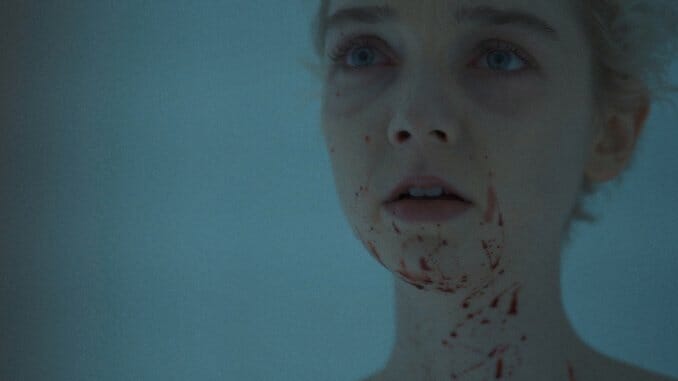
“Don’t you ever feel like you’re seeing something that you’re not supposed to?” Sarah (Julia Sarah Stone) asks Riff (Landon Liboiron), the scruffy Daniel Radcliffe stand-in conducting an ill-advised science experiment masquerading as a sleep study. After 45 minutes or so of mystery (and low-key stalking), Sarah confronts Riff AKA Jeremy about his tests and observations of his subjects’ fuzzed-up dreams: He wants to see what people dream of, and what their nightmares look like, in hopes of isolating an ancient, primal fear baked into the psyche of everyone alive and everyone who has ever lived. He also wants to cozy up to Sarah in ways both innocent and unethical, but for one moment, as they both stare into the eerie dreamscapes of her fellow participants, none of that really matters. What matters is the figure with the glowing eyes.
This is a key scene in Come True, Anthony Scott Burns’ horror first, sci-fi second hybrid film—essentially a dramatized version of what filmmaker Rodney Ascher gets at in his 2015 sleep paralysis documentary The Nightmare. What if your worst fears manifested in the real world? What if you couldn’t tell the difference between the land of the waking and the realm of the slumbering? What if the difference doesn’t even matter because, whether the nightmares are real or not, they still smother you and deny you rest, respite and sanity? Conceptually, the movie is frightening. In more practical terms it’s deeply unsettling, a terrific, sharply made exercise in layering one kind of dread on top of another. Sleep deprivation is scary enough, family alienation is depressing enough, being creeped on by a nerdy rando is disturbing enough—and that’s before the shadows haunting Sarah’s unconscious start to make an impression on the physical plane.
What writer/director Burns does so well here, apart from the film’s construction, is emulating the sense of being trapped in drowsing terrors which have neither end nor beginning. His intent appears to be disguising the point where Sarah’s nightmares first ensnare her, giving the viewer the sense that she’s always been ensnared, and thus doomed to remain in their clutches. Even the promise of a cure, or at least a treatment—offered by Jeremy’s boss, Dr. Meyer (Christopher Heatherington), and his peer, Anita (Carlee Ryski)—doesn’t provide Sarah relief from her malady. Maybe when you’ve lived with sleep paralysis and vivid nightmares as long as she has, there is no temporary relief. We first meet her cocooned in a sleeping bag on a playground slide, her eyes snapping open from her latest unwelcome rendezvous with her phantasmal tormentor. She doesn’t live at home. She doesn’t sit still, even when she dozes off in class. She can’t. She has no place to run from the figure. It’s ever-present, in a figurative sense…at least until the experiment goes wrong—as experiments do—and things get out of hand, and out of her head.
The audience, over time, begins to experience Sarah’s world the way she does: In the grip of constant grim anticipation of the next round of freaky dream imagery, which seem to be inspired by the paintings of Hieronymus Bosch and Henry Fuseli. Bosch captured visions of Hell while Fuseli captured paralysis via demonic visitations. The impact Stanley Kubrick has on Come True is obvious, too, even if the impact is only surface-level. Burns may intend the film to function as a companion to Kubrick’s work and to Ascher’s documentary, or he may simply have the same fascinations with sleep and nightmares as both. Either way, Come True rests nicely alongside these films, Renaissance triptychs and Romantic paintings, comfortably standing out thanks to Burns’ thoughtful, slow-burning propulsion.
Come True takes its time. But Burns’ screenplay is plot-heavy, so even the quiet beats communicate their necessity: Every minute counts toward the climax, each an essential piece of the film’s structure. The deliberate pacing meshes with the film’s nocturnal scares in a way that, even in daytime, invites us to scrutinize what we’re seeing in the frame, searching for devils, incubi and other monsters lingering at Sarah’s periphery. Come True asks us to look closely at the screen for evidence of her monster lurking just off to the side where nobody’s looking (and the trick, of course, is that when you find what you’re looking for, you may wish you hadn’t looked at all). It’s in the haze of a morning under the influence of bad REM sleep, or the dark corners of a hospital room, or the tracking lines of the footage Jeremy and his team capture from Sarah’s dreams. It’s everywhere.
Much as Come True relates to Ascher and Kubrick, the ever-present unnerving sensation that unspeakable terror is hovering over your shoulder puts the film in closer company with It Follows, another movie about disaffected youth on the run from evil they don’t understand and can’t fight. It’s contemporary, atmospheric and cuts deep—and more than that, it’s original. Burns conjures horror so vivid and tactile that at any time it feels like it might leap off of the screen and into our own imaginations or, worse, our own lives.
Director: Anthony Scott Burns
Writer: Anthony Scott Burns
Starring: Julia Sarah Stone, Landon Liboiron, Tedra Rogers, Carlee Ryski, Christopher Heatherington, Orin McCusker
Release Date: March 12, 2021
Bostonian culture journalist Andy Crump covers the movies, beer, music, and being a dad for way too many outlets, perhaps even yours. He has contributed to Paste since 2013. You can follow him on Twitter and find his collected work at his personal blog. He’s composed of roughly 65% craft beer.